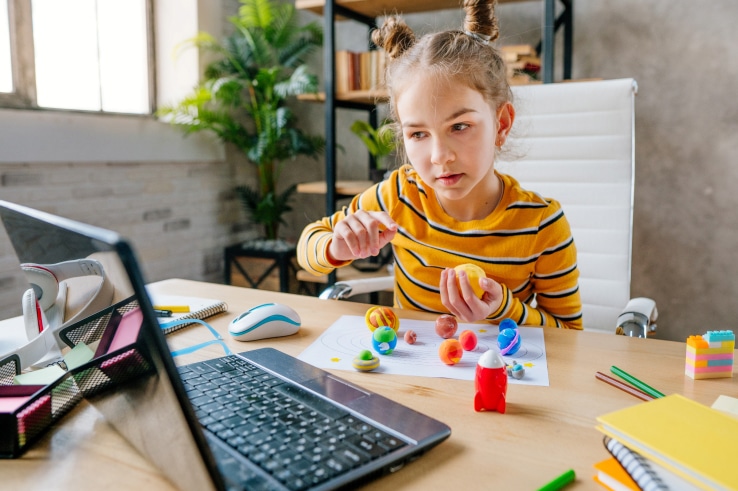
Christy O’Glee works as an Account Executive at Class after spending a decade in education. She is passionate about increasing educational opportunities for K12 students through innovative technology. When not working, she can be found traveling and spending time with her family.

Christy O’Glee works as an Account Executive at Class after spending a decade in education. She is passionate about increasing educational opportunities for K12 students through innovative technology. When not working, she can be found traveling and spending time with her family.

As educators and students come to the end of the traditional school year, research shows summer break is an invaluable time to keep students learning. While many learners and their families see this time as a “break” from education, the reality is that summer learning activities play a pivotal role in keeping students on track and progressing academically. Importantly, it should be pointed out that summer learning, just like traditional school year out-of-classroom assignments, can potentially exacerbate equity and access issues.
While this article promotes a variety of summer learning activities, the emphasis here is on promoting voluntary and/or supplemental learning experiences rather than mandatory checklists, which, as Education Week points out, have been shown to further intensify academic disparity. As Sackstein advocates, “Let’s spend more time in school promoting a culture of curiosity and learning that transcends school.” Learning during summer break provides an ideal platform for this strategy.
According to the National Education Association, “research shows that students benefit from quality summer and extended learning experiences, especially students from low-income communities who typically lack resources to extend their education beyond the school day.” K-12 summer learning is a great opportunity for young learners to voluntarily participate in supplemental education. Promoting healthy, effective summer learning activities should involve engagement from all parties—educators, students, and parents. Freeing summer learning opportunities from a physical classroom can also broaden engagement and heighten academic results.
The Education Development Center notes, “[summer learning] can help students catch up academically, connect with peers, and explore enriching activities.” One of the most valuable elements addressed is the opportunity to catch up academically. Virtual summer schools keep students learning during summer break, especially when participation is voluntary, as this encourages student enthusiasm.
In fact, a Wallace Foundation and EDC collaborative study around K-12 summer learning found an estimation that students in the treatment group were three percent more likely to enroll in a mathematics course above grade level and one percent less likely to enroll in a mathematics course below grade level after participating. Put another way, participants were more likely to not only “catch up” academically, but move ahead—and even less likely to remain behind.
Another important tool for impactful summer learning is tutoring. Not only can tutoring take on many different areas, from musical instruments to science labs and from foreign languages to physical fitness, it can also be accomplished in a variety of ways. As technology integrates more seamlessly into classrooms, effective tutoring no longer even requires in-person attendance.
One-on-one and small group tutoring unlocks new doorways to learning which can motivate students during summer break. U.S. Secretary of Education Miguel Cardona echoes this sentiment, noting in a recent U.S. News & World Report article, “The evidence is clear. High-impact tutoring works, and I’ve urged our nation’s schools to provide every student struggling with extended access to an effective tutor.” As technology’s role academically continues to evolve, access to tutors becomes even more expansive.
Just like tutoring, enrichment programs and summer learning activities are highly engaging ways to motivate students during summer break. Additionally, many of these programs are put on by organizations outside of a student’s education system, so funding and other potential hurdles are often addressed by third parties. These activities lean heavily into voluntary and supplemental participation since they usually are not directly connected to the student’s primary education provider. Programming can take on a variety of formats, including:
There are a number of science and technology-based “boot camps” designed as K-12 summer learning opportunities. Female-oriented coding camps, engineering and design competitions, and more are available to students—many even including scholarship availability to help absorb costs.
Learning during summer break doesn’t have to occur in a student’s school—or even in a student’s hometown. A helpful way to keep students learning during summer break can be to remove the appearance of “learning” altogether with immersive experiences. While these summer learning opportunities can be far more intensive and require appropriate planning, traveling to a new place or digitally communicating with others in another culture can have a robust influence on a student without even appearing to be academic in nature.
Whether learning a new musical instrument, writing poetry, or taking on a summer reading program, there are numerous ways to increase student involvement in the arts, focusing on hands-on application. In a 2022 article in The Journal, the Institute for Multi-Sensory Education advocated immersing students in learning through as many methods as possible.
As the National Education Association succinctly points out, “Parents are the experts on their child. Teachers are the experts on learning. Working together, they can form a shared understanding of what a child needs for success.”
Never more evident than during the quarantining stage of the COVID-19 pandemic, student learning is not solely the responsibility of either the parent or the educator. The same holds true for summer learning. By introducing technology into the educational process, parents—even those who work during the summer—can engage in summer learning activities alongside their children. Additionally, parent workshops explicitly designed for adults can provide helpful aid, assistance, and ideas on how to motivate students during summer break.
There is ample evidence of the repercussions of learning loss during the summer months when academics aren’t prioritized. The reality is, however, that summer serves as a ripe opportunity for academic success, which can be seen well into future school years. These voluntary and supplemental summer learning opportunities have only grown with the further melding of technology and classrooms.
Are you curious how robust, pedagogically sound technology can ignite summer learning activities for your district? Let’s chat today! At Class, we’re passionate about getting the right tools in the hands of educators to continue impacting future generations of learners.

Christy O’Glee works as an Account Executive at Class after spending a decade in education. She is passionate about increasing educational opportunities for K12 students through innovative technology. When not working, she can be found traveling and spending time with her family.

Christy O’Glee works as an Account Executive at Class after spending a decade in education. She is passionate about increasing educational opportunities for K12 students through innovative technology. When not working, she can be found traveling and spending time with her family.
Get our insights, tips, and best practices delivered to your inbox

Sign up for a product demo today to learn how Class’s virtual classroom powers digital transformation at your organization.

Features
Products
Integrations